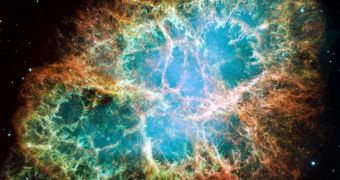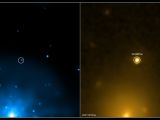Supernova SN 2007on was discovered last year in the location of what previously was a binary system, composed of at least one white dwarf and another stellar companion, most likely a regular slightly more massive star or possibly a second white dwarf. It is now known that the supernova is a Type Ia, meaning it was determined by the explosion of a white dwarf star. However, astronomers are now trying to determine the exact process that triggered the event, in order to be used as reference for future study of similar cosmic events.
Chandra X-ray Space Observatory had studied the binary system just four years before it went supernova, but failed to observe the imminence of the violent event. On the other hand, it is not yet clear if the respective binary system is responsible for the supernova SN 2007on, as it seems to have occurred slightly off the center of the location of the binary system.
A couple of astronomers from the Max Planck Institute for Extraterrestrial Physics in Germany and from Radboud University initiated a study to determine the exact circumstances in which the supernova event took place.
Type Ia supernovae are usually produced by the explosion of a white dwarf in a binary system, but there are two ways the explosion of the white dwarf may occur. The first one is by mass accumulation, meaning that the white dwarf approaches its companion too close, so that the powerful gravitational pull draws material from the regular star towards the white dwarf. The collected mass is then re-heated until nuclear fusion reactions are initiated, the white dwarf star becomes unstable and explodes.
The second situation requires the presence of two white dwarfs in a binary system and the supernova explosion is determined by the collision of the two. Because Type Ia supernova explosions are associated to white dwarf explosions, the ejected material is mostly rich in heavy chemical elements, such as iron, which can provide with additional tools in the study of dark matter and dark energy, but is mostly related to the cosmological problems of the universe.
Rasmus Voss, from the Max Planck Institute, says that, if the supernova explosion were to be the result of a mass accumulation, then the white dwarf would have had to emit high levels of X-ray radiation prior to the explosion, and subsequently the X-ray source disappears altogether. In the second scenario, however, the X-ray emission would have been extremely weak.
Observations with the Chandra X-ray Space Observatory four years ago seem to support the first scenario, as in the location of the supernova lied a fairly strong X-ray source possibility further backed up by the existence of very little powerful X-ray sources in that specific region of sky, and the signature of the X-ray signal is clearly that of a white dwarf accumulating this kind of material. But the uncertainty still remains, as the optical images seem to place the supernova slightly offset in relation to the X-ray source, even though it has disappeared since the explosion.
In the hope that they will finally solve the mystery behind SN 2007on, astronomers have started applying the same method to a series of other supernovae observed in the last years.

 14 DAY TRIAL //
14 DAY TRIAL // 
